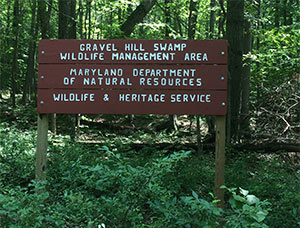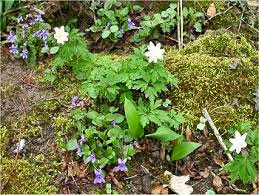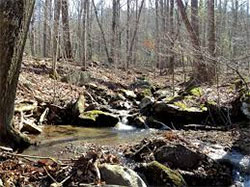 At only 68 acres in size, this relatively small wildlife management area is big in species diversity and richness. Located in the higher elevations of the Catoction Mountains of northwestern Frederick County, Gravel Hill Swamp offers protection to the headwaters of Buzzard branch an important Brook Trout stream. The swamp also provides important habitat for a number of rare, threatened and endangered plant species.
At only 68 acres in size, this relatively small wildlife management area is big in species diversity and richness. Located in the higher elevations of the Catoction Mountains of northwestern Frederick County, Gravel Hill Swamp offers protection to the headwaters of Buzzard branch an important Brook Trout stream. The swamp also provides important habitat for a number of rare, threatened and endangered plant species.
What to See
 The entire property is dominated by an oak/poplar forest with a thick understory of Spice Bush. White-tailed deer, wild turkey and black bear are some of forest wildlife species that can be found on the property. For the birding enthusiast the opportunity to spy a variety of flashy, forest interior birds in the upper tree canopy await you. During the warmer months, woodland flowers can be seen throughout the WMA. In the spring be on the lookout for colorful spring flowers such as Cut-leaf Toothwort, Spring Beauty and perhaps Wild Geranium. In some areas of the forest, the spring flowers are so numerous they can cover the forest floor. If you are the adventurous type, walk around the fringes of the “swamp” and you will be awarded with the sight of False Hellebore, Marsh Marigold, or Great Lobelia.
The entire property is dominated by an oak/poplar forest with a thick understory of Spice Bush. White-tailed deer, wild turkey and black bear are some of forest wildlife species that can be found on the property. For the birding enthusiast the opportunity to spy a variety of flashy, forest interior birds in the upper tree canopy await you. During the warmer months, woodland flowers can be seen throughout the WMA. In the spring be on the lookout for colorful spring flowers such as Cut-leaf Toothwort, Spring Beauty and perhaps Wild Geranium. In some areas of the forest, the spring flowers are so numerous they can cover the forest floor. If you are the adventurous type, walk around the fringes of the “swamp” and you will be awarded with the sight of False Hellebore, Marsh Marigold, or Great Lobelia.
Remember to only take pictures and watch your step as this WMA supports a number of rare, threatened and endangered plant species.
What to do
 For the hunting enthusiast this archery hunting only area offers the opportunity to pursue white-tailed deer, wild turkey and grey squirrels. For the non-hunter, this wooded property offers many opportunities to photograph colorful woodland flowers and birds. In the early spring the opportunity to collect wild moral mushrooms is a popular activity on the area.
For the hunting enthusiast this archery hunting only area offers the opportunity to pursue white-tailed deer, wild turkey and grey squirrels. For the non-hunter, this wooded property offers many opportunities to photograph colorful woodland flowers and birds. In the early spring the opportunity to collect wild moral mushrooms is a popular activity on the area.
Area Regulations
- Use of Gravel Hill Swamp WMA is generally permitted seven days a week throughout the year.
- Hunting is allowed in accordance with established seasons and hunting hours.
- Due to its small size, only archery hunting is allowed on the WMA.
- Trapping is not permitted.
- Disabled hunters may use the property by parking in several scattered pull-offs along the small gravel access road.
Special Areas
- Gravel Hill Swamp WMA is managed to provide important habitat for forest wildlife species.
- The area offers protection to the unique wetland area located on the site, which supports a number of rare plant species.
Non-Hunting User Guide
- Non-hunting visitors are welcome on the WMA.
- Be aware of open hunting seasons and visit accordingly.
- Bird watching, nature photography and mushroom hunting are popular uses of the area.
- Hardwood forest and wetlands compose all of the property and support a rich variety of songbirds and wildflower species.
- The area is relatively flat, which offers an easy stroll through the property.
Site Management Goals
The primary management goal of this wildlife area is to provide protection to this unique wetland and the number of rare, threatened and endanger plant species that the wetland harbors.
Directions
From I-70 west, take the Braddock Rd exit and continue east towards Frederick.. At the first light turn left (Old Camp Rd) and take another left at the next light. This should put you on US 40, west bound. Follow US 40 west for approximately 3 miles and make a right on to Gambrill Park Road. Continue on Gambrill Park Road for approximately 10 miles and the road will split. Keep to the left, which is Tower Road. Continue on Tower Road until the first left, which is Middlepoint Road. The WMA is located on the left. There is a small gravel lane approximately ½ mile up this road on the left, which will take you through the center of the WMA property. There are several small pull-off located along this gravel lane.
 Click here for map.
Click here for map.